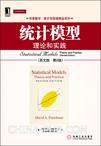统计模型
出版时间:2010-9 出版社:机械工业出版社 作者:弗里德曼 页数:442
Tag标签:无
内容概要
本书是一本优秀的统计模型教材,着重讲解线性模型的应用问题,包括广义最小二乘和两步最小二乘模型,以及二分变量的probit及logit模型的应用,还包括关于研究设计、二分变量回归及矩阵代数的背景知识。 这还是一本鼓舞人心的而又易读的书,无论是老师还是学生都会从中受益。
作者简介
(美)弗里德曼,是加州大学伯克利分校的统计学教授、杰出的数理统计学家。其研究范围包括鞅不等式分析、Markov过程、抽样、自助法等。他是美国科学学院士。在2003年。美国科学院授予他John J.Carty科学进步奖,以表彰他对统计理论和实践做出的贡献。
书籍目录
Foreword to the ReVised EditionPreface1 Observational Studies and Experiments 1.1 Introduction 1.2 The HIP trial 1.3 Snow on cholera 1.4 Yule on the causes of poverty Exercise set A 1.5 End notes 2 The Regression Line 2.1 Introduction 2.2 The regression line 2.3 Hooke's law Exercise set A 2.4 Complexities 2.5 Simple vs multiple regression Exercise set B 2.6 End notes3 Matrix Algebra 3.1 Introduction Exercise set A 3.2 Determinants and inverses Exercise set B 3.3 Random vectors Exercise set C 3.4 Positive definite matrices Exercise set D 3.5 The normal distribution Exercise set E 3.6 If you want a book on matrix algebra4 Multiple Regression 4.1 Introduction Exercise set A 4.2 Standard errors Things we don't need Exercise set B 4.3 Explained variance in multiple regression Association or causation? Exercise set C 4.4 What happens to OLS if the assumptions break down? 4.5 Discussion questions 4.6 End notes5 Multiple Regression: Special Topics 5.1 Introduction 5.2 OLSisBLUE Exercise set A 5.3 Generalized least squares Exercise set B 5.4 Examples on GLS Exercise set C 5.5 What happens to GLS if the assumptions break down? 5.6 Normal theory Statistical significance Exercise set D 5.7 The F-test "The" F-test in applied work Exercise set E 5.8 Data snooping Exercise set F 5.9 Discussion questions 5.10 End notes6 Path Models 6.1 Stratification Exercise set A 6.2 Hooke's law revisited Exercise set B 6.3 Political repression during the McCarthy era Exercise set C 6.4 Inferring causation .by regression Exercise set D 6.5 Response schedules for path diagrams Selection vs intervention Structural equations and stable parameter:Ambiguity in notation Exercise set E 6.6 Dummy variables Types of variables 6.7 Discussion questions 6.8 End notes7 Maximum Likelihood 7.1 Introduction Exercise set A 7.2 Probit models Why not regression? The latent-variable formulation Exercise set B Identification vs estimation What if the Ui are N? Exercise set C 7.3 Logit models Exercise set D 7.4 The effect of Catholic schools Latent variables Response schedules The second equation Mechanics: bivariate probit Why a model rather than a cross-lab? Interactions More on table 3 in Evans and Schwab More on the second equation Exercise set E 7.5 Discussion questions 7.6 End notes8 The Bootstrap 8.1 Introduction Exercise set A 8.2 Bootstrapping a model for energy demand Exercise set B 8.3 End notes9 Simultaneous Equations 9.1 Introduction Exercise set A 9.2 Instrumental variables Exercise set B 9.3 Estimating the butter model Exercise set C 9.4 What are the two stages? Invariance assumptions 9.5 A social-science example: education and fertility More on Rindfuss et al 9.6 Covariates 9.7 Linear probability models The assumptions The questions Exercise set D 9.8 More on IVLS Some technical issues Exercise set E Simulations to illustrate IVLS 9.9 Discussion questions 9.10 End notes10 Issues in Statistical Modeling 10.1 Introduction The bootstrap The role of asymptotics Philosophers' stones The modelers' response 10.2 Critical literature 10.3 Response schedules 10.4 Evaluating the models in chapters 7-9 10.5 Summing upReferencesAnswers to ExercisesThe Computer LabsAppendix: Sample MATLAB CodeReprints Gibson on McCarthy Evans and Schwab on Catholic Schools Rindfuss et al on Education and Fertility Schneider et al on Social CapitalIndex
图书封面
图书标签Tags
无
评论、评分、阅读与下载
用户评论 (总计10条)
- 对统计模型的理解,是很棒的。尤其是英文的。对你的英文有很大的提高。
- 作者不愧是美国科学院院士,写作深入浅出,对概念的内涵和边界把握的非常精到,简直到了一刀解决战斗的程度。习题及其解答也是一个宝藏。修订版还加入了经典论文选读部分,方便读者学以致用,以实例为参照应用和检验所学。
更难得的是,弗老很有幽默感!我第一次看统计学书笑出来! - 可以提高英语的阅读速度;介绍了平时一般的统计人疏忽的细节,课后练习较有循序渐进的层次。
- 书的内容不用多说大师写的,可是这本书好像发霉了,好像受过潮死的,本来一本好好的正版书变的蜡黄,实在可惜,当当还要卖给消费者,哎,如此经营。。。。。。
- 和同类的教科书相比,这本书给人的感觉是简单,但很清新.很多在其他书上表述极为复杂的东西,这本书里都用很直观,生动地方式进行了阐述.是大师之作!
- 书内容非常想尽,但要有一定的专业英语的基础。
- 上课要用的,所以买了,很不错,里面的内容很具有代表性~
- 英文版,内容上很好,纸张有点差。
- 上个月买的这本书,快递很快,包装还可以。不过书纸张似乎不好,不是很白。总体感觉还行啦,喜欢英文原版的书。
- 书还不错,送货速度太慢了,上海本地发货,居然5天才到,也许过年期间物流速度慢吧,对这个速度不是很满意.
书封皮有点皱,不过新还是蛮新的,马马虎虎吧.
